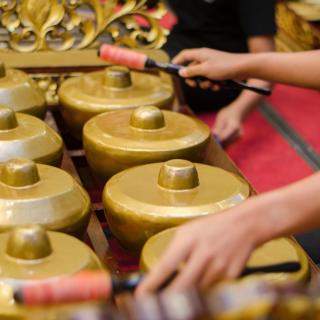Gamelan Suprabanggo
In Indonesia, whether in small villages or lavish royal estates, alone or accompanying dance, drama, and puppet theater, gamelan music is considered essential for official ceremonies, life-cycle rituals, and celebrations.
The instruments comprising the Yale Central Javanese Gamelan Ensemble came to Yale in 2006.
... On hearing gamelan for the first time, some people are struck by the complexity of the relationships between the melody lines of the different instruments …. others focus on the mellifluousness of the sound and the soothing, meditative quality of some of the music. Still others are excited by the multileveled interlockingness of the texture, comparing it to the experience of listening to several, incredibly good jazz solo players improvising together.”
Founding director of Yale Gamelan Suprabanggo; former associate professor in the Department of Music
Glossary
Gamelan: A Javanese/Indonesian word for ensemble. The word “gamel” means to hammer something. A Central Javanese gamelan consists primarily of bronze instruments — horizontal and vertical gongs and metallophones — but also includes several stringed instruments, flutes, drums, and voices in performance. Gamelan orchestras are the traditional accompaniment to wayang shows, dances, feasts and ceremonies of Indonesia. Gamelan music consists of smooth, “impressionistic” tone clusters and intensely complex intertwining rhythms and textures.
Wayang: Javanese wayang kulit or wayang purwa - a dramatic form involving puppetry — derived from a Javanese Hindu-Buddhist tradition, where hand-crafted leather puppets are used to depict epic stories of the gods in shadow play.
Dhalang: The wayang puppeteer — in performance, employs the combined arts of puppet movement, dialogue, songs and commentary.
Klenengan: Javanese gamelan music, played in soft and contemplative style, used for listening entertainment rather than for the accompaniment of a dramatic theatrical event.


